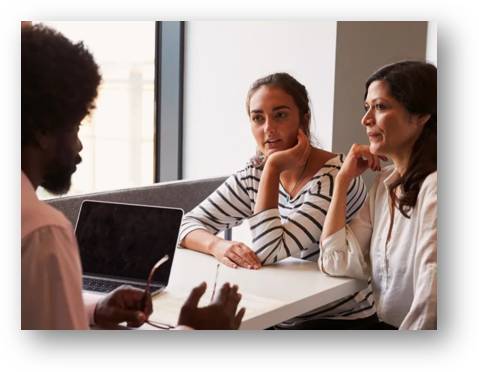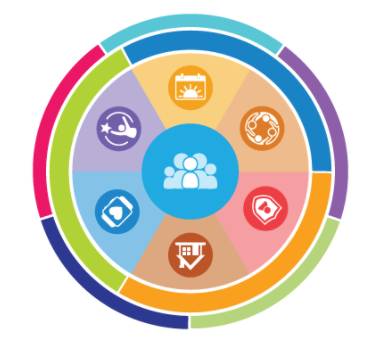Navigation
Empowering Students Introduction
Key Elements
- Supported Decision Making
- Maintaining High Expectations
- Making Informed Choices
- ► Person-Centered Planning
- Social Emotional Learning
Resources: Empowering Students
Person-centered planning (PCP) refers to focusing on the individual’s goals while still assuring individual needs are met, for example food, shelter, educational opportunities, and others. As we consider education and a student centered planning process, the educational team develops the IEP, focusing on the interests, strengths, skills, and needs of the student. There are a number of considerations when using a PCP process:
- Remember the student is a person and should be viewed as an individual versus a diagnosis or disability.
- Develop goals based on the individual needs of the student including their strengths, interests, and capabilities.
- Speak to the student in a way they understand and can relate to, not using professional language they might not understand; break down information or frame it differently so the student can understand what is being communicated. Ask the student to explain it to you so you can assure understanding or if clarification is needed.
- Include individuals in the transition planning and process that have a broad understanding of the student’s academic and social history.
Learn more about PCP in the learning activities below.
Charting the Life Course (CtLC)
Charting the Life Course (CtLC): The CtLC framework was created to help individuals and families of all abilities and all ages develop a vision for a good life, think about what they need to know and do, identify how to find or develop supports, and discover what it takes to live the lives they want to live. The core belief is: All people have the right to live, love, work, play and pursue their own life aspirations. This framework is truly a comprehensive PCP. It is designed for individuals, family members, and in supporting others in person centered planning.
- Go to: Getting Started with LifeCourse
- Access any of the free webinars to learn more about Charting the Life Course (CtLC)
- Access the LifeCourse Library to access the LifeCourse Framework to learn about the structure of CtLC, Foundational Tools, and other resources.
Minnesota Department of Human Services, Person-Centered Practices
Minnesota Department of Human Services, Person-Centered Practices: Minnesota focuses on Person-Centered Practices, which includes Person-Centered Planning. There is a focus on ensuring all receiving services can live, learn, work, and enjoy life in integrated settings, and a person-centered support system is needed to achieve this outcome. This approach honors individual choices and helps individuals build and maintain relationships with family and friends; obtain employment and engage in other preferred activities; be involved in community life; and be as independent as possible. Person-centered practices must be flexible and adaptable, include informed choice, and increase quality of life. Key information includes:
- What are person-centered practices?
- What’s the difference between person-centered practices and person-centered planning or thinking?
- What do person-centered practices address?
- How do other models of support and support planning connect with person-centered practices?
- How are person-centered practices and Minnesota's Olmstead Plan related?
- What are the benefits of person-centered practices?
- What does it mean for a person to have informed choice? Does informed choice apply to children?
- What does informed choice look like for people subject to civil commitment or people who have guardians?
- What resources exist for lead agencies?
Related Learning Activities:
- Read the information on the MN person-centered practices page.
- Download the workbook: What Does Person-Centered Mean for Me? I control. I dream. I choose. I participate.
- Review the brochure to determine if it is a tool to share with students. It is written in a user friendly manner and students could be coached in responding to questions.
Virginia Commonwealth University, Rehabilitation, Research, and Training Center
Virginia Commonwealth University, Rehabilitation, Research, and Training Center: Webinar covers the importance of using person-centered planning tools for autistic individuals pre-k through adulthood. The importance of developing skills, abilities, knowledge, and confidence in one’s self and developing through the years will be emphasized. How to adapt tools to meet the various communication needs of individuals and their support networks was also covered.
Related Learning Activities:
- Review webcast: Looking Toward the Future Using Person-Centered Planning Tools Pre-K through Adulthood (58:49).
- Download video transcript, PowerPoint handout, and/or Word Handout for the webcast to follow along and for future reference.
- Write down five concepts you learned during the webinar.
- Review Culturally Sensitive Person Centered Planning (downloadable article).
- Review Additional Person Centered Planning resources at VCU (articles, fact sheets, briefs, book chapters).
Family Engagement
Person-centered planning (PCP) is a strength-based ongoing process where the individual’s voice is central to planning for the future. It focuses on the individual’s strengths, interests, passions, and goals and during transition planning, helps in identifying appropriate transition goals, and a vision for what the individual wants for a life after high school. Consideration must be given to the family’s cultural and ethnic background. Participating in the PCP process helps the individual increase self-advocacy skills in coordinating services after high school, understanding types of assistive technology needed, building relationships and getting needed support, identifying community resources, and locating and applying for services which address needs for eligible services. Examples of goals might be planning for and obtaining employment, engaging in recreational activities, and living independently. Families are an important part of this process and can provide guidance to their adult children in becoming more independent and participating in the PCP process.
- IRIS Center, Vanderbilt: Person-Centered Planning and Planning for the Future
- Michigan Alliance for Families Video: Person-Centered Planning (53:26)
- Think & Plan: Site with Interactive PCP Tools
- MDHHS: Person-Centered Planning
- Michigan Alliance for Families: Self-Determination and Person-Centered Planning
- Michigan Alliance for Families Video: Person Centered Planning
- Wayne State University, Developmental Disabilities Institute (DDI)
- Self-Determination & Person Centered Training - MI-DDI Training Request Form

Navigation
Empowering Students Introduction
Key Elements
- Supported Decision Making
- Maintaining High Expectations
- Making Informed Choices
- ► Person-Centered Planning
- Social Emotional Learning
Resources: Empowering Students


